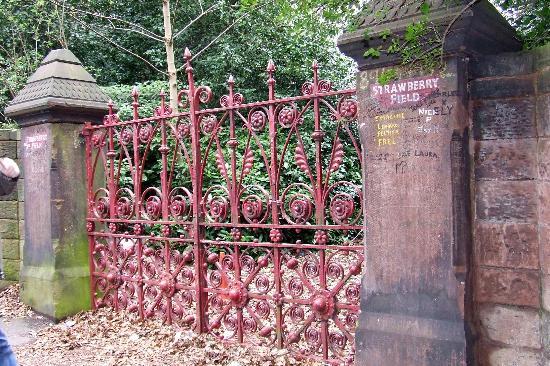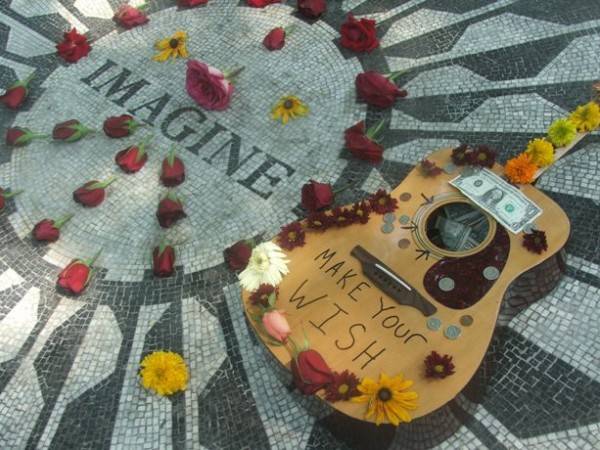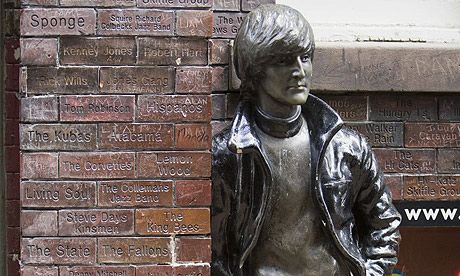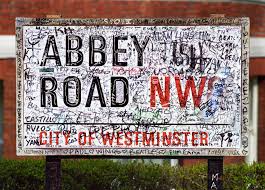5. Strawberry Fields, Liverpool

Another Liverpool place immortalized through song, Strawberry Field was the name of a Salvation Army Children’s Home not far from Mendips. John used to visit the ground every year for a garden party, and nicknamed the wooded area behind the house “Strawberry Fields” (plural). Later, when writing a hazy, drug-induced song about nothing being real, he somehow linked it to the play areas of his childhood.
The house is now a church and prayer center and the original gates have been replaced with new, but identical ones. As you’d expect from a Beatles sight, there is graffiti everywhere. Don’t feel like you have to add to it if you visit…
4. 3, Savile Row, London

One of the least remarkable-looking Beatles sights, with so much Beatles history contained within. Among the bespoke tailors of Mayfair’s Savile Row, the Beatles moved into number 3 in 1968 and set up Apple Corps, an umbrella company that covered a multitude of interests, from Apple Retail (the actual boutique was near Baker St) to Apple Electronics.
In many ways, Apple was a classic case study in how not to run a business, with the gorgeous shopgirls at Apple Boutique turning a blind eye to hippy shoplifters and £300,000 being spent on the work of “Magic Alex” down in Apple Electronics. “Magic Alex” spent a long time tinkering with LEDs to produce the “Nothing Box” but never did anything productive and was one of the many casualties of the rationalization of the business by Allen Klein a year later. The various businesses collapsed in financial ruin, although Apple Records continued to release recordings and still does.
The building is notable not only for housing Apple Corps but for hosting the Beatles’ very last live performance together, which was a spontaneous rooftop gig halted by police. A must-see if you’re a Beatles fan in London.
3. Central Park, New York

As any John Lennon fan will know, Central Park has a particularly poignant meaning as not only where the singer spent his last few years, but also where he met his death in December 1980. To honor him, the park has designated 2.5 acres as “Strawberry Fields“, a permanent memorial that features the word “Imagine” in the middle of a mosaic. Fans often gather there on significant occasions, such as the anniversary of his death, but have also used it for solemn times such as immediately after the September 11th attacks. The area is designated a “quiet zone” and is ideal for fans wanting to pay tribute to their icon or just “turn off your mind, relax and float downstream”. John would have liked it.
2. The Cavern Club, Liverpool

And so to where it all started…although by the time the Beatles were playing the Cavern, they’d already been together a long time and had played some lengthy seasons on Hamburg’s Reeperbahn with their then drummer Pete Best and bassist Stu Sutcliffe. But the Cavern was where it started to come together for them – in Hamburg, they’d been met with indifference but at the Cavern, they were adored. The basement club was dangerously overcrowded at times, as fans surged towards the stage the Fab Three were playing on (Pete Best was still in Ringo’s spot at this point, although Stu Sutcliffe had left). It was there that they were discovered by Brian Epstein in 1962, and stardom was a 12-bar blues riff away. Unsurprisingly, it is now a Beatles Museum, featuring statues of the band and memorabilia but it also still hosts live music acts.
1. Abbey Road, London

Now, for the most famous Beatles sight. It’s an unassuming zebra crossing in North London, but it featured on one of the most recognizable and parodied album covers ever. Plus, it’s just outside the Abbey Road studios where the Beatles recorded some of their greatest hits. A word of warning for anyone trying to recreate that zebra crossing shot – the road is extremely busy and the bus drivers are unsympathetic. They will try and mow you down before you can say “I’ll be Ringo”. But it’s an essential sight for anyone interested in Beatles history.